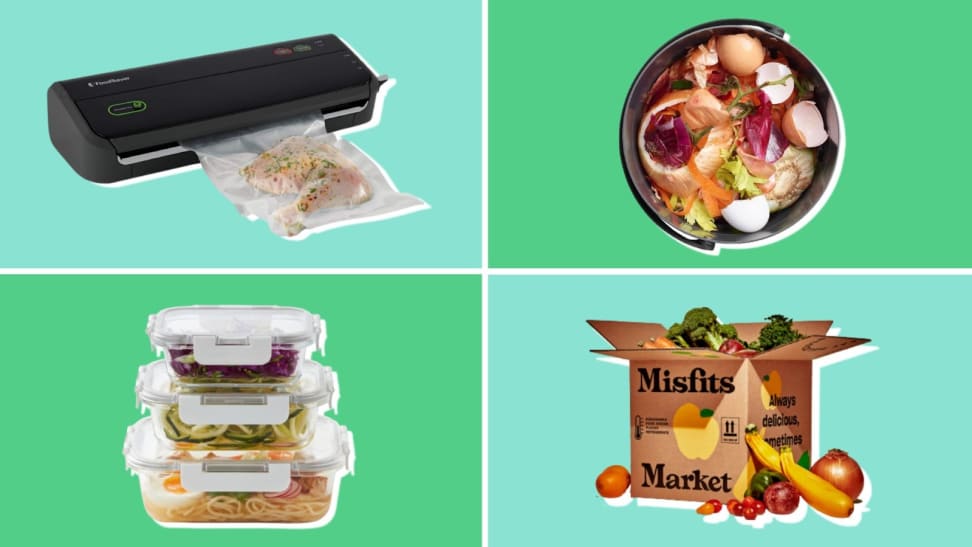 Credit:
Reviewed / FoodSaver / Misfits Market / Vitamix / Williams Sonoma
Credit:
Reviewed / FoodSaver / Misfits Market / Vitamix / Williams Sonoma
Products are chosen independently by our editors. Purchases made through our links may earn us a commission.
Most people are guilty of wasting food every now and then. Maybe you bought a too-big tub of spinach and it got slimy before you used it, or you forgot about the chicken breast in your freezer and tossed it away when it got freezer burn.
Unfortunately, food waste is all too common, and while it might not seem like a big deal to throw away items you’re not going to eat, these types of daily choices can add up—especially when everyone makes similar ones.
Here’s what you need to know about food waste in the U.S., including how it impacts both society and the environment, as well as several strategies for reducing food waste in your home.
Everything you need to know about food waste
How much food is wasted in the U.S.?
Each year, 30 to 40% of America’s food supply goes to waste, according to the United States Department of Agriculture (USDA). This equates to more than 100 billion pounds of food annually.
Food waste can happen at any stage in the supply chain—when it’s being grown, food can be spoiled by insects; it can go bad before it’s sold in a retail store; or it might be purchased and thrown away by consumers.
Why is food waste a problem?
There are several reasons why food waste is considered a problem in the U.S.
When perfectly good food isn’t eaten, it increases food insecurity, which is when people do not have access to the food they need. This is especially true of low-income households, who would benefit greatly if more unwanted food was donated to food banks.
The food itself isn’t the only thing being wasted, either. Land, water, labor, and energy are all required to produce food. And when food is unused, these resources also go to waste.
How does food waste affect the environment?
Believe it or not, food waste also has a negative impact on the environment. When billions of pounds of food end up in our landfills, it creates an abundance of methane, a powerful greenhouse gas, as it rots.
This gas is one of the driving forces behind global warming—the International Energy Agency estimates that methane is responsible for around 30% of the rise in global temperature since the industrial revolution. If less food was sent to landfills, less methane would be released into the atmosphere each year.
How to reduce food waste?
There are many ways that you can reduce food waste at home, several of which are outlined below.
Small steps—such as better meal-planning and more conservative shopping habits—will allow you to throw away less food. But you can also help keep food waste out of the landfills by composting.
The task doesn’t fall solely on you and me, though. There are also large-scale efforts being made to reduce food waste among large corporations, which are responsible for a large chunk of annual waste.
In particular, the USDA and U.S. Environmental Protection Agency (EPA) have a goal to cut food loss and waste by 50% by the year 2030.
The initiative, called the U.S. Food Loss and Waste 2030 Champions, encourages businesses and organizations to reduce food loss and waste in their own operations. Brands like Amazon, Walmart, Unilever, and more are current participants.
8 ways to reduce food waste
The good news is that it’s not hard to reduce food waste at home. If you’re willing to shop and cook a little more consciously, you might be surprised at how little food you end up throwing away! The following are eight strategies you can use to reduce your household’s annual waste.
1. Plan meals before you buy

Meal kits are a great way to reduce food waste and ensure you utilize all the ingredients in your fridge.
Have you ever picked up a nice ripe tomato at the supermarket, thinking “I’ll use this to make something this week,” but then you just…don’t? This often results in food waste, but you can prevent it by planning ahead.
To reduce food waste and save money, try planning out all your meals before you go grocery shopping. If you know exactly what you need to buy to feed your family for the week, you won’t come home with all sorts of extra items that might end up going to waste.
Another way to tackle this issue is by using a meal kit delivery service. These convenient services only send the ingredients you need to make the meal. And there are many available today, making it easy to find one that suits your tastes. (P.S. Our favorite is Home Chef, but plant-based folks should consider Purple Carrot.)
2. Shop at home first

Before you head to the grocery store, take count of everything you already have in your fridge and pantry.
After you make your grocery list for the week, take a minute to “shop” in your pantry before you head to the store.
You may have forgotten about that bag of rice on the top shelf or the onion in the back of the fridge. And by using items you already have instead of buying new ones, you can reduce the chances of having to throw food away.
3. Store food properly

Investing in high quality food containers—like this set from Pyrex—could mean spending less money on food in the long run.
It can be hard to remember all the rules for storing different foods. (Do tomatoes go on the counter or in the fridge?)
However, when you take the time to store food properly, you can extend its shelf-life, reducing the risk that it goes bad before you get to use it. Utilizing tools like high quality storage containers (this Pyrex set is our favorite) and your fridge's crisper drawers can lengthen the shelf life of your precious fruits and veggies.
The FoodKeeper App is a good resource if you want more information on how to store food to preserve its freshness.
You may also want to double-check that your fridge is set at or below 40°F and your freezer to 0°F. If these temperatures are too high, food will spoil faster. A good fridge thermometer is an easy and affordable way to ensure your foods are being stored properly.
4. Learn about labels

FYI: Not all expiration food labels are created equal!
We all know someone who throws food away if it’s even just a day past the expiration date. The FDA explains that this type of confusion over date labeling is responsible for roughly 20% of consumer food waste.
“Best if used by” dates only indicate the time when a product will be at its best flavor and quality; it doesn’t necessarily mean the food shouldn’t be consumed after that date.
Be smart and use your best judgment, particularly when it comes to spoil-prone foods like fresh meat and produce. But especially when it comes to processed foods, look for any signs (or smells) or spoilage before throwing it out.
What about “sell by” dates? These are used on refrigerated items to provide guidance for retailers, letting them know when to remove food from their shelves. However, food is often still good for weeks after the “sell by” date, so you shouldn’t take this as a firm expiration date. Again, check the appearance and smell of the food to see if there are any signs of spoilage.
The only time expiration dates are firm are if the label says “expires on” or “do not use after.” These terms are generally reserved for infant formula and medications.
5. Purchase imperfect produce

Subscribing to a service like Misfits Market will help reduce all the aesthetically imperfect (but delicious!) produce that otherwise goes to waste.
If you’ve ever been apple picking, you know that not every fruit that comes off a tree has that perfect apple shape. Unfortunately, most retailers don’t want misshapen produce, and items with cosmetic defects are often thrown away, despite being perfectly edible.
To help reduce this kind of food waste, there are several brands that now sell “imperfect” produce directly to consumers. We love Misfits Market, for its wide variety of grocery offerings and its money-saving aspect (Misfits claims its products come at up to 40% off grocery store prices).
6. Take advantage of your freezer
Your freezer is your friend when it comes to reducing food waste. If you have meat, bread, or other food that you suspect will go bad before you get around to eating it, you can increase its lifespan by freezing it until you’re ready to cook.
We recommend using a vacuum sealer, especially when freezing foods like meat and fish over long periods of time to avoid freezer burn.
7. Compost uneaten food

Turn your food scraps into gardening gold with a composter or food recycler.
It’s very challenging to get rid of all your household’s food waste. Even if you use up the majority of the food you buy, things like potato peels or coffee grounds are generally destined for the trash. However, you can keep these items from ending up in the landfills by composting them instead.
Composting is the process of breaking down organic materials into nutrient-rich soil. While it was once only possible for those with a yard, there are several ways you can compost in an apartment these days.
Countertop food recyclers turn food waste into a soil amendment in a matter of hours (with very little effort), and many communities have drop-off centers where you can bring food scraps to be composted.
8. Get a few backyard chickens

Taking care of a few backyard chickens will lessen your food waste and supply you with fresh eggs—a win-win!
If you’ve been looking for an excuse to get a few chickens, here’s a great one: Chickens are surprisingly effective at reducing the amount of household food waste that you send to the landfill, as they’ll eat just about anything.
Because they’re omnivores, chickens will happily eat things like produce scraps, stale bread, and even leftover meat. And as an added bonus, you’ll get fresh eggs out of the deal! Just be sure to secure a well-rated chicken coop before welcoming these friends into your backyard.
The product experts at Reviewed have all your shopping needs covered. Follow Reviewed on Facebook, Twitter, Instagram, TikTok, or Flipboard for the latest deals, product reviews, and more.


